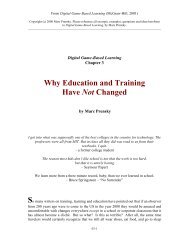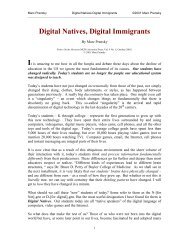Digital Wisdom - Marc Prensky
Digital Wisdom - Marc Prensky
Digital Wisdom - Marc Prensky
Create successful ePaper yourself
Turn your PDF publications into a flip-book with our unique Google optimized e-Paper software.
<strong>Marc</strong> <strong>Prensky</strong> From <strong>Digital</strong> Natives to <strong>Digital</strong> <strong>Wisdom</strong> © 2011 <strong>Marc</strong> <strong>Prensky</strong><br />
_____________________________________________________________________________<br />
with how we teach, which is still, primarily, through an outdated<br />
“lecture” or “telling” style very much at odds with how today’s<br />
students learn. This led me to the concept of “partnering,” which is the<br />
core of my book Teaching <strong>Digital</strong> Natives—Partnering for Real<br />
Learning.<br />
Reflecting on technology’s role in education led me—despite my being<br />
a strong proponent of using digital technology for learning—to the<br />
distressing conclusion that our educators, in their push to get our<br />
classrooms and education up to date, too often add technology before<br />
the teachers know, pedagogically, what to do with it. Unfortunately,<br />
because of the speed with which our technology now moves, this often<br />
leads to the technology’s becoming obsolete before it can ever add<br />
value. So despite huge financial investments, educational technology is<br />
often not realizing its great promise to improve our kids’ education. I<br />
therefore think about the role technology should play in the learning<br />
process; my answer: technology only helps when it supports a<br />
pedagogy of “Partnering” (“The Role of Technology in Teaching and<br />
the Classroom”).<br />
Above all, thinking about what students need to know and do in the<br />
21st century has shown me clearly that the deepest underlying problem<br />
with our current education is neither how we teach, nor the stillmissing<br />
technology—rather it’s what we teach. Our educators and<br />
students are stuck—for many historical reasons—with a curriculum<br />
that is highly outdated and of very little use in preparing our kids for<br />
the lives they will be facing. The Herculean struggle to get our kids to<br />
learn this mostly “useless” stuff, and to get “up to grade in it,” is<br />
taking up, and wasting, almost all our time and effort. As a result,<br />
much of what today is touted as “educational reform” is really just<br />
“rearranging the deck chairs on the Titanic”: we are applying Band-<br />
Aids to an education that is in need of a blood transfusion. Even the<br />
many well-intentioned proposals to add on “21st century skills” are not<br />
truly helpful, since without first deleting we have no room to add<br />
anything (“The Reformers Are Leaving Our Schools in the 20th<br />
Century”).<br />
Have My Ideas Changed?<br />
A question I continually asked myself when rereading each of these essays for the book<br />
is, “Have my ideas changed since I wrote this?” I found that, in most cases, they<br />
haven’t—I still believe strongly what I wrote. But occasionally they have, and I find this<br />
good, because some ideas, like some parts of education, should evolve with the changing<br />
times and context. In the cases where my thinking has evolved, I have commented on this<br />
6










